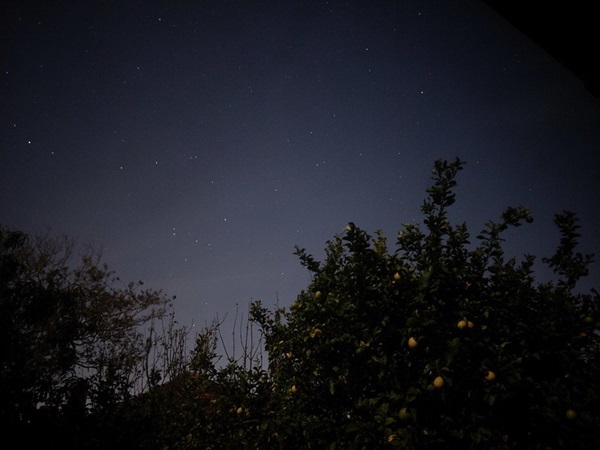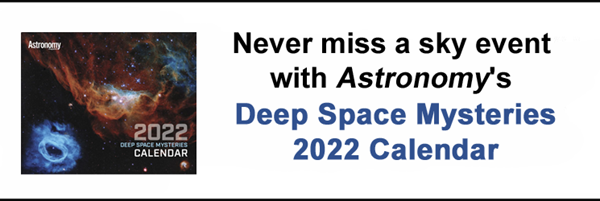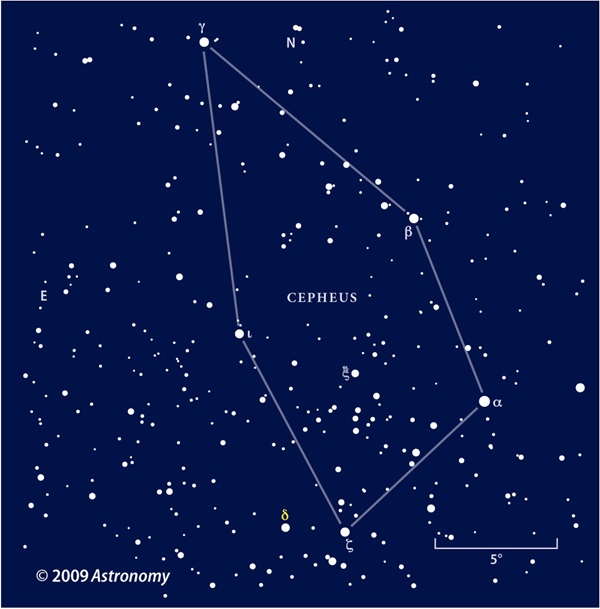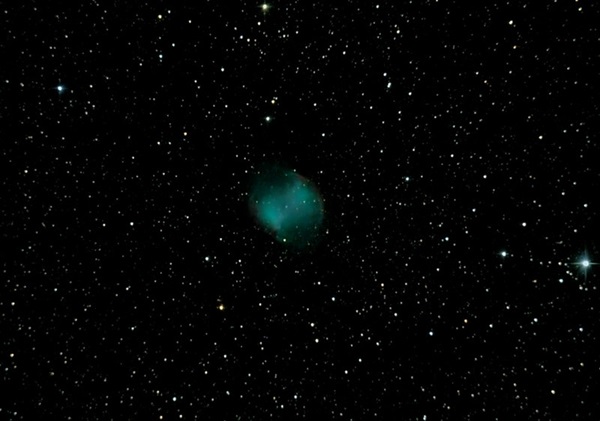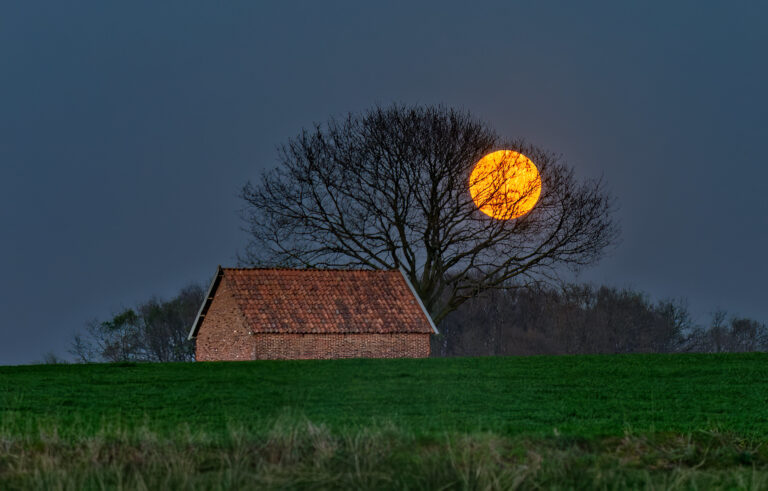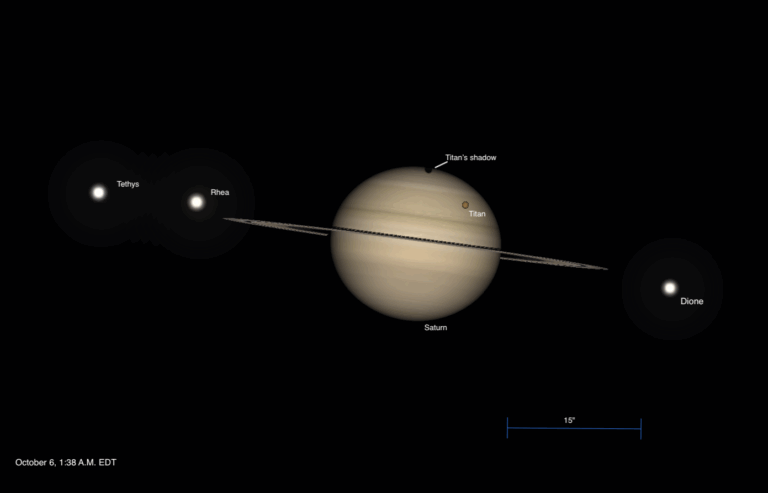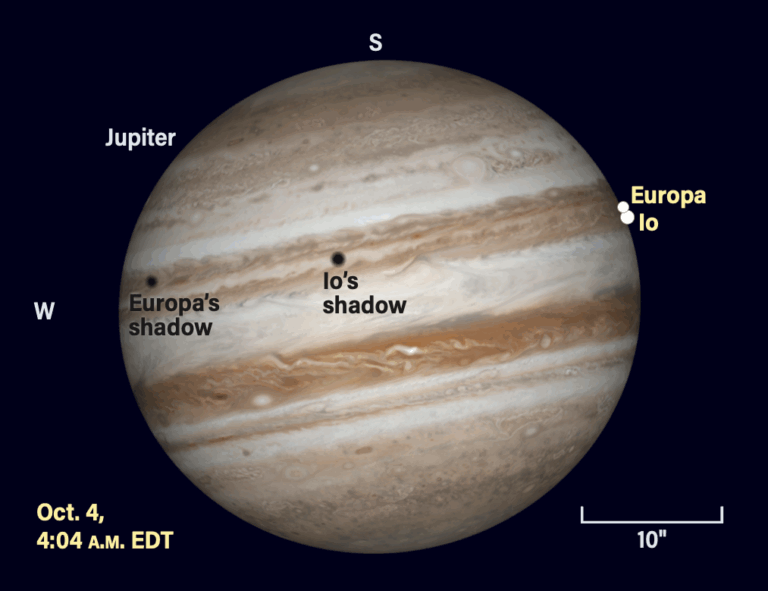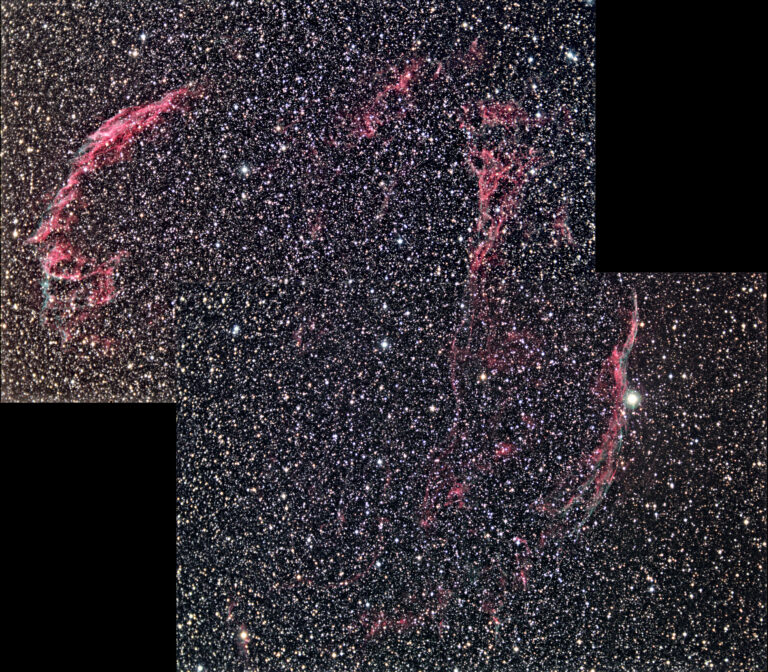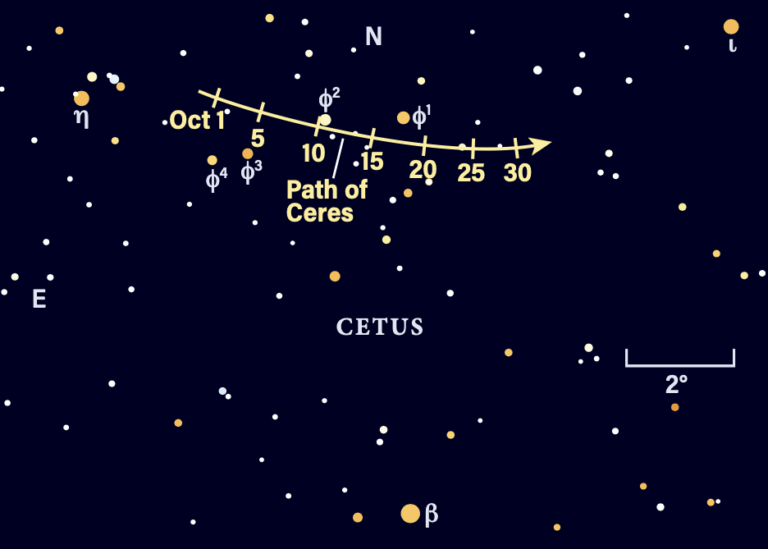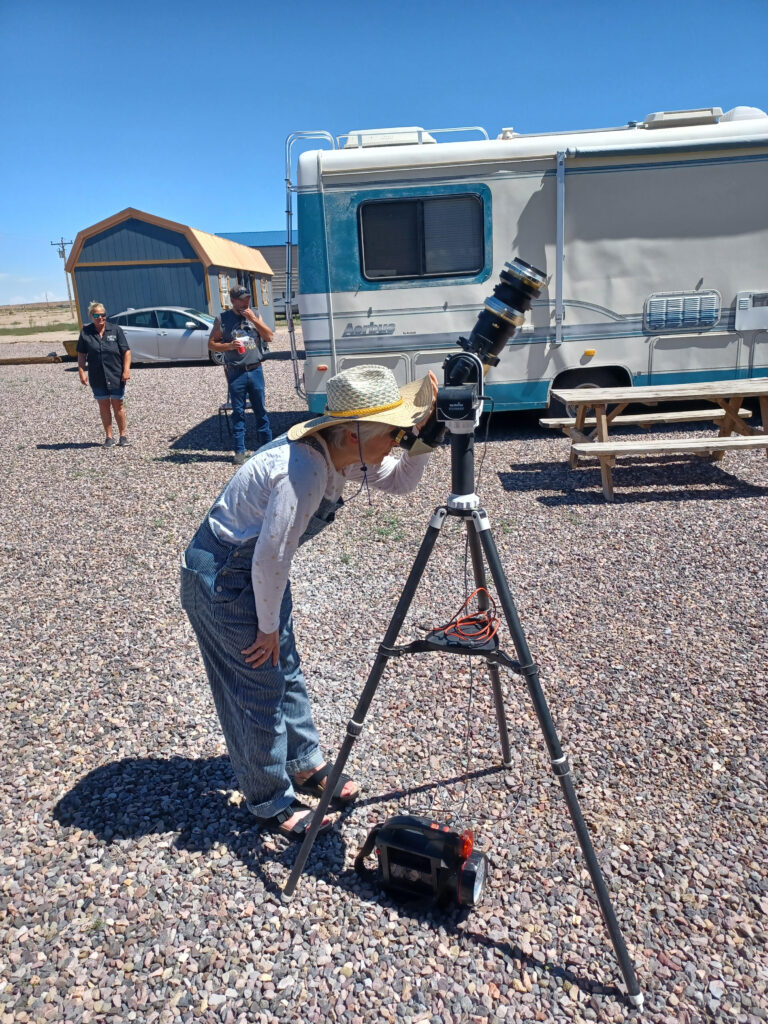Key Takeaways:
Friday, August 27
As the stars begin to appear after sunset, turn your gaze southwest to see the curving body and tail of Scorpius the Scorpion low on the horizon. This southern constellation is already setting but, depending on your location, you’ll have an hour or two to marvel at his star-studded form. Running from west to east are Scorpius’ claws, head, heart, body, and tail. The constellation’s brightest star is Antares, a 1st-magnitude red supergiant star reminiscent of Betelgeuse in Orion the Hunter’s shoulder. Antares sits about 550 light-years away and shines some 10,000 times brighter than our Sun. Its relatively cool surface temperature lends this star its ruddy hue, for which it was named the rival of Mars.
Sitting to Scorpius’ upper right just after sunset is Libra the Balance. Shaped a bit like a lopsided house, Libra’s alpha star is magnitude 2.8 Zubenelgenubi. (Note that it’s not actually the constellation’s brightest star, a title that goes to magnitude 2.6 Beta [β] Librae, also called Zubeneschamali.) But this star hides a surprise: It’s a naked-eye double star, much like the more famous Mizar and Alcor in the Big Dipper. Roughly 4′ to Zubenelgenubi’s northwest is a second, fainter magnitude 5.2 star. Astronomers believe the two are physically related in space as well, moving together through the Milky Way. Can you make out each separate star? Note that this pair is closer than Mizar and Alcor, which are separated by a wider space of nearly 12′.
Sunrise: 6:23 A.M.
Sunset: 7:39 P.M.
Moonrise: 10:28 P.M.
Moonset: 11:32 A.M.
Moon Phase: Waning gibbous (74%)**
*Times for sunrise, sunset, moonrise, and moonset are given in local time from 40° N 90° W. The Moon’s illumination is given at 12 P.M. local time from the same location.
Saturday, August 28
The Moon passes 1.5° south of Uranus at 5 A.M. EDT. You’ll find the pair high in the southern sky at that time, sitting in southeastern Aries the Ram. To their northwest is Aries’ alpha star, 2nd-magnitude Hamal. To their south (directly below them) is the head of Cetus the Whale, marked by the bright (magnitude 2.5) star Menkar. And to the pair’s northeast is the Pleiades star cluster (M45), often visible as a tiny, dipper-shaped asterism in Taurus the Bull.
Our Moon is slightly more than half-lit; above it, Uranus glows a soft magnitude 5.8, just at the edge of naked-eye visibility. The Moon’s light, however, will likely wash the planet out, so your best bet is to find its 4″-wide, bluish-gray disk with a pair of binoculars or a small telescope. Slightly closer to the Moon, just under 1° from our satellite’s northern limb, is the magnitude 5.5 star Sigma (σ) Arietis.
Sunrise: 6:24 A.M.
Sunset: 7:37 P.M.
Moonrise: 10:55 P.M.
Moonset: 12:32 P.M.
Moon Phase: Waning gibbous (65%)
Sunday, August 29
Corona Borealis the Northern Crown is a little-known but easy constellation to find. After sunset tonight, locate bright Arcturus (magnitude –0.1) about 40° high in the west. With Sirius still below the horizon, Arcturus is the brightest star Northern Hemisphere observers will see in the sky. (To that star’s lower left, much closer to the horizon, shines brilliant Venus at magnitude –4.)
About 20° above Arcturus is the curve of Corona Borealis. Magnitude 2.2 Alphecca, which sits west of the center of the constellation’s semicircular shape, is the Crown’s alpha star. Its beta star, just northwest of Alphecca, is named Nusukan. The Crown can be drawn from seven stars: moving counterclockwise, these are Iota (ι), Epsilon (ϵ), Delta (δ), Gamma (γ), Alpha (α), Beta (β), and Theta (θ) Coronae Borealis.
The Moon reaches apogee, the farthest point from Earth in its orbit around our planet, at 10:22 P.M. EDT. At that time, it will sit 251,096 miles (404,100 kilometers) away.
Sunrise: 6:25 A.M.
Sunset: 7:36 P.M.
Moonrise: 11:26 P.M.
Moonset: 1:33 P.M.
Moon Phase: Waning gibbous (56%)
Monday, August 30
Last Quarter Moon occurs early this morning at 3:13 A.M. EDT. Early risers should certainly take the time to enjoy our satellite’s partly lit face, visible above the V in Taurus, where the Hyades open star cluster sits. About 5.5° below the Moon is Aldebaran, the bright red eye of the Bull.
Even if you don’t want to get up early, you’ll be able to check out the Moon until after noon in most U.S. time zones. The best — and easiest feature — to find is the terminator, which is the line where night meets day on the lunar surface. Surface features stand out most in this area, where the shadows are sharpest.
The Last Quarter Moon can also show us the direction of Earth’s orbital motion. That’s because during this phase, the Moon’s location in its orbit around Earth just happens to be in line with the exact direction Earth is moving through space as it orbits the Sun. Looking up at the Last Quarter Moon shows the space Earth itself will occupy about three and a half hours later.
Sunrise: 6:26 A.M.
Sunset: 7:34 P.M.
Moonrise: —
Moonset: 2:32 P.M.
Moon Phase: Waning crescent (46%)
Tuesday, August 31
Mars, Mercury, and Venus stand in a line behind the setting Sun this evening. Faint Mars will likely sink out of sight too quickly to easily find, but brighter Mercury (magnitude 0) is 3.5° high in the west 30 minutes after sunset. Far easier to spot is magnitude –4 Venus, 16° east-southeast of Mercury and less than 6° from Spica, Virgo the Maiden’s brightest star. See how long it takes for this luminary to appear against the darkening twilight, sitting to the upper left of Venus. Over the next week, Venus will approach and then pass by this star, moving farther east along the ecliptic.
For those with a clear view of the horizon, turn a telescope on Mercury once the Sun has completely disappeared. The planet’s face is 74 percent illuminated and spans just 6″. Venus is nearly three times this size, showing a 73-percent-lit face.
Sunrise: 6:27 A.M.
Sunset: 7:33 P.M.
Moonrise: 12:02 A.M.
Moonset: 3:31 P.M.
Moon Phase: Waning crescent (37%)
Wednesday, September 1
The American Association of Variable Star Observers’ featured variable star of the month for September is Delta Cephei, a 4th-magnitude star in southeastern Cepheus. Despite its lack of a proper name past the Greek letter designation, this star is the archetype of an extremely famous class of stars called Cepheid variables.
These variable stars are one of the most important items in an astronomer’s toolkit when it comes to measuring the distance to other galaxies. Today, researchers can use a relationship called the Leavitt Law to determine the distance to any Cepheid variable, simply based on how long it takes the star to change brightness. That’s because there is a known relationship between a Cepheid’s period and its intrinsic brightness, which researchers can then compare to how bright the star appears and calculate its distance from the difference.
Cepheus is a circumpolar constellation, meaning it is up most or all of the time for observers in the Northern Hemisphere. After sunset tonight, look for the house-shaped constellation already high in the north, sitting above the upright W asterism in Cassiopeia. Delta Cephei is about 2.5° due east of 3rd-magnitude Zeta (ζ) Cephei, which marks the lower left corner of the constellation’s “house” (when pictured upright). Tonight, about an hour after sunset, Delta will appear directly beneath Zeta.
It only takes a week or two to notice Delta Cephei’s changing brightness. The star shifts from magnitude 3.6 to 4.3 and back to 3.6 in a little more than 5 days. Revisit this star over time and compare it to the stars around it; with a practiced eye, you just might be able to recognize its regular changes.
Although it’s the namesake of this class, Delta Cephei (which lies some 890 light-years away) isn’t the closest Cepheid to our planet. That title goes to another famous star: The North Star, Polaris, in the Little Dipper is the closest Cepheid to Earth, at a distance of just under 446 light-years.
Sunrise: 6:28 A.M.
Sunset: 7:31 P.M.
Moonrise: 12:45 A.M.
Moonset: 4:26 P.M.
Moon Phase: Waning crescent (28%)
Thursday, September 2
M27, better known as the Dumbbell Nebula, is a famous planetary nebula in the lesser-known constellation Vulpecula the Fox. Despite their name, planetary nebulae have nothing to do with planets. Instead, they are created as aging stars puff away their outer layers, lighting up these gauzy curtains until, no longer generating light through fusion, the central star grows too dim and the nebula goes dark forever.
Finding M27 is simple with a go-to scope, but you can also star hop relatively easily to this magnitude 7.6 nebula with binoculars or a manual telescope as well. Start with bright magnitude 3 Albireo in Cygnus, which marks the head of the Swan. From there, drop 3.3° south-southwest to magnitude 4.5 Anser (Alpha Vulpeculae). Just over 5.5° east of Anser is magnitude 4.6 13 Vulpeculae, also cataloged as HD 188260. Finally, M27 sits just less than 2° southeast of 13 Vulpeculae (or 7.3° east-southeast of Anser, if you prefer to use this star as your last bright signpost).
The first planetary nebula ever discovered, the Dumbbell will look spherical or slightly oblong in binoculars, while a telescope will bring out the two lobes for which it is named. The object has a high surface brightness, meaning you can pump up the magnification to get more detail without sacrificing visibility.
Sunrise: 6:29 A.M.
Sunset: 7:30 P.M.
Moonrise: 1:35 A.M.
Moonset: 5:16 P.M.
Moon Phase: Waning crescent (20%)
Friday, September 3
Rising in the southeast as darkness falls after sunset are the solar system’s giant planets, Jupiter and Saturn. Brighter Jupiter (magnitude –2.9) sits near magnitude 2.8 Deneb Algedi in eastern Capricornus. With a telescope, you should be able to see a few of its distinctive colored cloud bands, as well as its four largest moons. Just after sunset in the Eastern and Central U.S. time zones, Ganymede sits alone on the planet’s east. To the west, Io and then Europa are closer to the Jupiter’s limb, while Callisto lies much farther west.
Just after 10:30 P.M. EDT, Io disappears behind the planet. Keep watching, and Europa does the same, a little over an hour later (at 11:42 P.M. EDT). Jupiter’s shadow stretches out to the planet’s east, so even though Io clears the disk around 12:50 A.M. EDT Saturday morning (late Friday elsewhere in the U.S.), it won’t become visible until it slips out of the shadow around 1:11 A.M. EDT. Europa suffers a similar fate: It emerges from behind the disk just after 2:30 A.M. EDT Saturday morning, and finally clears the shadow around 3:23 A.M. EDT.
About 17° west of Jupiter is magnitude 0.3 Saturn. Zoom in on it with a telescope to first enjoy its stunning rings, which stretch about 42″ across. Once you’ve looked your fill, then find the planet’s largest, brightest moon, magnitude 8.5 Titan. Tonight, Titan sits about 1′ north of Saturn, while several other of the ringed planet’s dimmer moons — 10th-magnitude Rhea, Dione, Tethys, as well as 12th-magnitude Enceladus — cluster closer to the rings.
For those with large amateur scopes or astrophotography equipment capable of reaching past 14th magnitude, asteroid 949 Hel sits just beyond Titan, about 1.5′ to Saturn’s north tonight. This tiny main-belt asteroid is a little less than 40 miles (64 km) across and was discovered in 1921.
Sunrise: 6:30 A.M.
Sunset: 7:28 P.M.
Moonrise: 2:32 A.M.
Moonset: 6:00 P.M.
Moon Phase: Waning crescent (12%)

